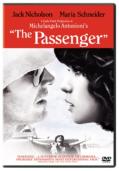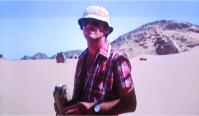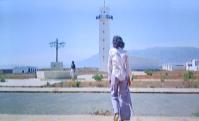The Passenger (1975) (aka Professione: reporter) dir. Michelangelo Antonioni writ. Mark Peploe, Peter Wollen, M. Antonioni cine. Luciano Tovoli edt. Franco Arcalli & Antonioni art. Piero Poletto music. Ivan Vandor costumes. Louise Stjernsward
 star. Jack Nicholson
(Locke/Robertson) Maria Schneider (Girl) Jenny Runacre (Rachel Locke) Charles
Mulvehill (Robertson/dead man) Ian Hendry (Martin Knight) James Campbell (witch
doctor) Ambroise Bia (Achebe) Manfred Spies (German) Jean-Baptiste Tiemele
(thug) Angel del Pozo (police inspector)
star. Jack Nicholson
(Locke/Robertson) Maria Schneider (Girl) Jenny Runacre (Rachel Locke) Charles
Mulvehill (Robertson/dead man) Ian Hendry (Martin Knight) James Campbell (witch
doctor) Ambroise Bia (Achebe) Manfred Spies (German) Jean-Baptiste Tiemele
(thug) Angel del Pozo (police inspector)
MGM 1975 anamorphic widescreen 126 mins | color
DVD Sony Pictures Classics 2006
about coincidence & fate
|| The anticipation which Antonioni's film The Passenger generated prior to its release in 1975 owed something to the counter-culture's fascination with the desert, its mystery and natural minimalism... and of course Antonioni's reputation as a dramatic artist on the same level as Samuel Beckett and Harold Pinter, unconventional stage writers who seem to have had at least a passing influence on the great Italian muralist. Autistic dialogue, indolent action, mental and spacial alienation... in small doses, dysfunctional humans acting out their psychodramas within beautiful landscapes and designer plazas was an appealing art style.
There was something of science fiction in it, an alternate-world gestalt, like a zombie colony on another planet. The opening scene of L'eclisse (1962) is so slow & non-verbal, it's as if the actors are waiting for the director to arrive while the camera runs. Yet the style -- good for the one-act play format -- was fatiguing in a 2 hour drama. Even the prof and the students got weary in the darkness, longed for a gun fight and a sexual rendezvous. Is this why The Passenger received a lukewarm reception on its release? Too slow, too arcane and self-conscious in its attempt to be hip?

Fall 05, you read that the star, Jack Nicholson, owns the master print and is organizing its release as a remastered DVD. Your first thought was, hmm, is Nicholson, the guy who started out as an ivy league ingenue in the bent flicks of Roger Corman now seeking some academic recognition because, let's face it, Hollywood still doesn't have the same cachet as Old Europe? So you buy a copy, let it lie on the floor beside the plasma wide screen for a couple of days before settling down with a glass of shiraz, skeptical yet hopeful. Thirty years ago maybe you smoked a joint before entering the theatre as you believed insight = THC squared. Thus the lingering prejudice that The Passenger was/is a derivative mistake, the first clear marker of Antonioni's decline and fall as a significant filmmaker.
Wrong... or mostly wrong. True, much of it looks like a Godard road movie (Pierrot le Fou in particular) but now perhaps you can see it properly. You were looking at a 16 mm print back then. If Antonioni went dark, it wasn't due to the creative failure of The Passenger. Not only does the film look good (despite those wobbly, human pans) with its multi-cultural settings and characters, the story is an excellent example of the non-linear narrative. Plot? There's a plot alright, even if you are forced into the ellipsis that surrounds each incident in order to understand it. And how difficult is this? At times, watching an Antonioni film can be like watching a surveillance video, and The Passenger is no different. It takes the same patience and attention that an afternoon in the art museum requires.
|| A journalist called David Locke (Jack Nicholson) is in North Africa, trying to make a documentary on some rebels in the southern Sahara (probably the Polisari). A failed attempt at contact leads to him abandoning his Land Rover in the sand and walking back in the scorching heat to his one star hotel in a village oasis with no name and few inhabitants. He needs a shower but the hotel has no soap, so he decides to ask a fellow guest, a man called Robertson. He finds Robertson lying on his bed, dead. As he goes through Robertson's belongings, some aspects of his identity are revealed... but not all. It's as if he's a stencil for an identity -- one which Nicholson decides to assume when he sees how easy it would be to swap their passport photographs.
Yes, there's a facial resemblance between the two. But at this point, you don't really know what Nicholson is doing here or what his relationship is to Robertson... who later turns out to be a gunrunner with a bad heart. Later on a flashback reveals that Nicholson is a a journalist making a documentary, although it's much later in the story that you learn what Robertson is/was up to way down here where the Blue Men roam. Thus Nicholson's new identity is both a process of discovery and abandonment.
the doppelganger
Why would he do this? Why, in a remote hotel in North Africa, would he exchange identities with a stranger? A bad, frustrating day in the desert to be sure, but what would induce a moderately successful journalist (that even Robertson has read) to do such a thing? The with-holding of information is usually subject to the point-of-view. Thus, as the cast come one by one or two by two into the action, the mystery is (paradoxically) both deepened and illuminated... and thus a thriller format is used to disguise an ambitious paradigm about coincidence and fate.
Cut To: Locke's London townhouse where his wife is watching TV and a group of fellow journalists discussing her husband's death in Africa. There's no great distress in her expression. Later, you learn that she has a lover... and there, at least, is one motive for Locke/Nicholson's actions. More information is revealed when she goes to the studio, watches rushes from the documentary, etc. The viewer is now catching up, although he/she has come into the story late. This is the classic "in medias res" narrative form, i.e. starting in the middle of the story.
Thus Locke becomes a "passenger" in Robertson's identity. He returns to London, burgles his own house, gets some float money and then, using Robertson's date book, follows Robertson's itinerary, flies to Munich, meets with two brokers for the rebels, receives payment in an old church, agrees to meet them in Barcelona on September 5 for further business. He rents a car, drives to Barcelona, wanders into a post-nouveau building designed by Antonio Gaudi, encounters a young woman (who is never named) who says she's a student of architecture.

She looks pretty good, seems to have an intuitive grasp of just what "Robertson" is all about... or at least enough to go along for the ride. Maria Schneider. You recall her previous movie, naturally: Last Tango In Paris. Shocking stuff at the time and perhaps it clouds your perception of her acting. Possibly you anticipate a pornographic incident, although it never happens. In truth, she acts well, and her character is convincing. She has a natural persona, an aspect of non-acting, that softens the often heavy dialogue with its pointed sub-text and malingering pauses. In this sense the literary medium of language innuendo is partially concealed by the documentary medium of real-time film. Nicholson's character has something to hide, whereas Schneider's is ambiguous. You're never sure if she's innocent or part of the hunt. Even by the end, her role in determining Nicholson's fate remains ambiguous. She might be an agent of Destiny... or she might be a casualty of coincidence.
One thing for sure: she's nice to look at. It's easy to follow along with her and Nicholson as she first aides in his escape from Barcelona, then becomes his accomplice in his run down the Costas del Brava and del Sol... following the itinerary set forth in Robertson's date book. A dangerous stranger? What does she care. So maybe Nicholson/Robertson's a gunrunner, maybe he isn't. Romance requires fiction, a flight from the past... although, typically the past is in pursuit of the present. Not only are government agents (of the Saharan republic where the revolt is taking place) closing in, but also his wife and Martin Knight, his documentary film associate, the latter determined to make a tribute documentary about him in lieu of their stalled African project.
Nicholson's wife discovers the passport switch whenever she recovers his gear from the African consul in London. Her suspicions deepen as she views the footage returned with the camera, listens to a conversation on the Uher. Most of this "play-within-the play" is elliptic, has more to do with symbolism than story exposition, and, as a narrative device, will remind some of the darkroom photo blowup sequences in Antonioni's London film, "Blow Up" (1967). Consider Nicholson/Locke's interview with the "witch-doctor": "Mr. Locke, there are perfectly satisfactory answers to all your questions... but I don't think you can understand how little you can learn from all of them... your questions are much more revealing about yourself than my answers can be about me." A head-game artist in dreadlocks? At this juncture, you, the viewer, is the one asking the questions, the one desiring clarification.
30 years later, certain aesthetic choices made by Antonioni and his collaborators seem less problematic. At the time, Jack Nicholson seemed wrong for the role of a UK TV journalist. He seemed to be a stand-in or an understudy, a need to appeal to the American market by using an American actor. And casting Maria Schneider as the love interest seemed nothing more than a crass production ploy to mate "Last Tango In Paris" with "Easy Rider"... and behind that, a tap of a standard Godard pairing such as Belmondo and Anna Karina. Big on fantasy, low on detail, these characters were as slight and existential as stolen shadows.
Today, of course, you can see it all in the post-modern context, cut it a bit of slack, compare it to Hitchcock, and marvel at the Antonioni touch. As always, there are a number of scenes in The Passenger that could only have been drawn by Antonioni. Nicholson's first sighting of Maria Schneider on a bench on an elevated plaza in London... Nicholson/Locke's discovery of Robertson's body & recognition of the doppelganger... the failed rendezvous at the white geometric village known as the Plaza de la Iglesia... and the brilliant ending at the Hotel de las Glorias.

how you begin, how you end
The ending of The Passenger is a masterpiece of real-time cinematic articulation in the same way as, say, the famous opening 3 minute tracking shot of Orson Welles' expressionistic Touch of Evil (1958). As any serious narrative hustler knows, only two things really matter when telling a story: how you begin, how you end. Antonioni has always favored symbolism and mime, two things film can use very well... rooted, as it is, in the silents. To be sure, an Antonioni ending doesn't always work as well as it should [i.e. the mysterious ritualism of the tennis game in Blow Up], but usually it does. The endings of Il Grido, L'Avventura and La Notte are like paintings, full of stasis, symbolism and mystery.
The ending of The Passenger has all the mystery and potential of a metaphysical painting by Giorgio de Chirico, and is so provocative it could function by itself or as the opening of the film. The point-of-view is everything, a line-of-sight from the foot of Nicholson's bed through the barred window that overlooks a dusty gravel plaza and the wall of a bull ring that looks like an ancient Roman amphitheatre. The sound is ambient and desultory... the only music a faint distant trumpet, as if an unseen bull fight is underway... or the memory of a bull fight. As in a zoetrope, various figures appear, stage right, stage left... disappear, reappear... an old man and his dog... Maria Schneider, pacing... the bad guys crawling past in a small Fiat... the cops arriving... and Rachel Locke.
And so on. It's a convergence, as in a thriller... but unlike a thriller, the action is anti-dramatic. It could be a dream-fever, the past and the present coming together as the mundane. It's an inversion of a dramatic tradition, a reversal like the visual and verbal palindromes Antonioni uses so effectively in L'Avventura. Here, identities reverse, roles reverse. Locke's wife is a widow in a fiction, yet also a widow in a fact. The action is as remote and impersonal as slowly passing clouds.
And all the while you're unaware that the camera is moving genty towards the window and through bars into the yard. Magic? Some will recall a similar astral move at the beginning of Citizen Kane, but if you want to know how it was done, listen to Jack Nicholson's commentary track. As for the compositional style, de Chirico's famous 1913 painting The Red Tower is worth comparing or any of his early street/plaza paintings.
The cop says to Mrs. Locke, "Do you recognize him?" No. He asks Maria Schneider (who still remains unnamed), who says, "Yes, I knew him."
As usual, the DVD contains commentary tracks, although none by Antonioni. Mark Peploe, the main scenarist, reveals a lot of interesting stuff about how the script was written, what Antonioni added or changed, and even talks about an aborted project which preceded The Passenger, a film to be shot in Sardinia and Brazil starring Jack Nicholson as a journalist, and using a narrative of two parallel stories intercut. Called "Technically Sweet", it seems from Peploe's brief description to have been a dry run for The Passenger. A comparison of the scripts will make an interesting study for some film student.
look through any window
Jack Nicholson's commentary (separate) is also excellent, reveals that he knew exactly what this film is about and quite understandably rates The Passenger as his greatest experience as a film actor. "In an Antonioni film you see things rather than hear them," he says as he explains the difference in method between the maestro and directors of the usual music-driven melodramas of the commercial cinema. He's right, of course, as the audio is virtually all ambient noise from beginning to end [consider: the clever use of the running shower as Locke discovers Robertson's body & eventually drags it into his room to switch identities]. And while Jack has had some terrific roles over the years, the cool documentary persona that Antonioni introduced him to perhaps deserves reconsideration. He is good as Locke/Robertson -- and not just because he was able to prop up Maria with a hidden hand.... You want the details? Listen to his commentary.
The Passenger should be a sad story, but the objective distance -- the spacial alienation -- of the Antonioni method flattens our emotions. Somewhere in the narrative he includes documentary footage of a real execution in some African nation. The writer Mark Peploe admits he has moral issues with this... but the fact is that it looks no more or less real than any other scene in The Passenger. Some will even rate the parable of the Blind Man that Nicholson/Robertson relates to Maria Schneider in the orchard as more emotionally provocative because, after all, language excites the imagination while film excuses it.
Look through any window, and what do you see? "A little boy and an old woman. They're having an argument about which way to go." This exchange between Nicholson and Schneider is an analogue for their own situation, of course, but it also encapsules the Antonioni method.
© LR 5/06